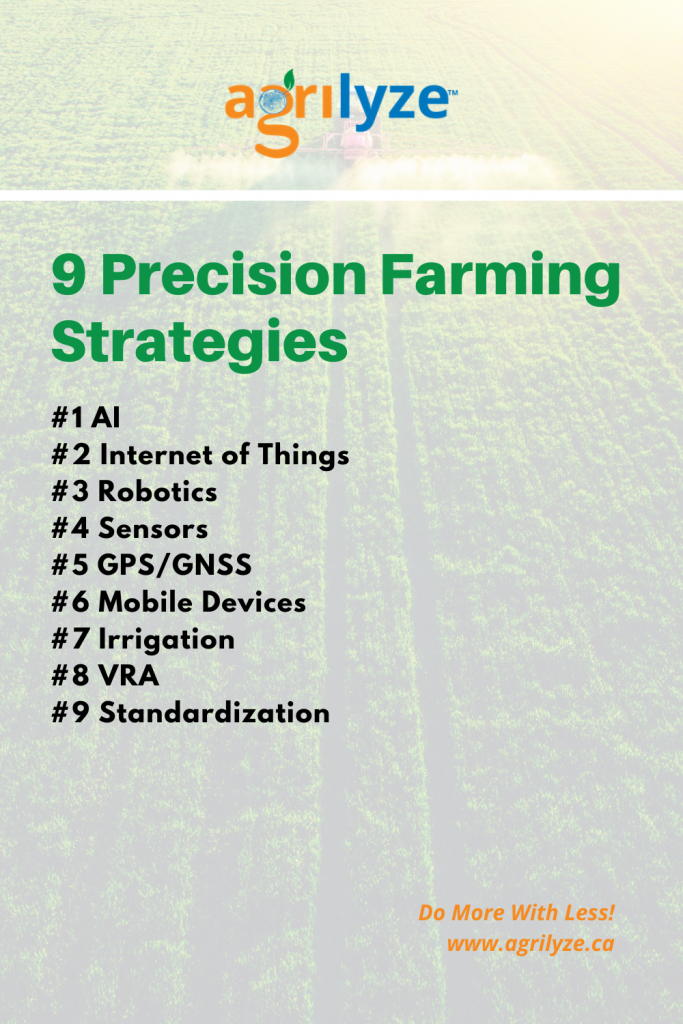How the Modern Farmer Works – 9 Precision Agriculture Strategies
Today, we review nine technologies that are changing the face of farming today. Farmers everywhere are looking toward precision agriculture as a means to improve their operations. Two factors that affect our need for precision agriculture strategies are the rising global population, which is creating an increased demand for food supply and changing weather conditions, which is forcing farmers to find new and innovative ways to combat adverse weather due to climate change. Combined with a need to produce more while doing less, precision techniques enhance the productivity of farms. We hope this article is useful to you, and if you have any suggestions for future topics, please let us know!
#1 AI
Precision agriculture uses AI technology to aid in detecting diseases in plants, pests, and reduced plant nutrition on farms. AI sensors can detect and target weeds and then decide which herbicides to apply within the right buffer zone. In addition to ground data, farmers are also taking to the sky to monitor the farm, using remotely sensed imagery from drones.
#2 Internet of Things
Not only a buzzword. The whole idea behind IoT is connection. Connection with a device with a means to turn it on and off via the internet. One example of IoT being applied today is in smart homes using smart appliances. On the agriculture side, IoT is very much connected to the idea of smart farming, as many experts believe it to be a revolution that is transforming traditional practices, particularly with pesticide and fertilizer usage and in improvements with the overall automation of a farm. Other examples of connected components in agriculture are field sensors, which can be used to log weather, soil moisture, and temperature data in real-time. From a global perspective, IoT technologies will enable better food traceability, which in turn will lead to increased food safety.
#3 Robotics
As they say, robots are replacing human beings; it can’t be all that bad in farming. Robots take on many tasks and can be remotely controlled using telematics. Telematics involves automating decisions or actions at a distance. So, the idea is that a farmer cannot precisely apply seeds and fertilizer to their fields. Instead, the task would be meticulously mapped using machinery with the proper soil sensors. Then, the farmer’s smart machinery would apply seeds and fertilizer at variable rates based on the soil characteristics, such as nitrogen levels, organic matter content, and moisture at various locations in the field.
#4 Sensors
In agriculture, wireless sensors are used to collect various types of data, including soil water availability, soil fertility, and other plant and climate-related analytics. Through the use of sensors, farmers can begin to understand their crops at a micro-scale, conserve resources, and reduce impacts on the environment.
#5 GPS/GNSS
It seems that GPS may have been the first tool that has been used to help farmers manage their fieldwork with more ease and accuracy. When agriculture gained access to position locating satellites in the 90s, farmers began to collect data in real-time and use devices to map where resources could be used, as well as increase resource use in an efficient way. Today, farmers can turn on their tractor and get to work. Furthermore, satellite capabilities have become more global, hence the term GNSS or Global Navigation Satellite Systems. Indeed, our capacity to work better has increased.
#6 Mobile Devices
The advent of the cell phone on the farm has proved to be irreplaceable. Other mobile devices, such as tablets, are also helping farmers to farm better. They can know that the resources of that farm will be used appropriately and to increase resource efficiency. These days, operators expect to obtain the information they require within 20 minutes. If not, then the farmer is likely never to use it.
#7 Irrigation
It is crucial to be continually innovating when it comes to water application, as water scarcity from drought and aquifer depletion can cause multi-level issues with farm operations and crops. Systems allow growers to monitor and control the entire irrigation process remotely, saving water, time, fuel, and wear and tear on vehicles. Irrigation is hugely vital to farming – it helps to cultivate superior crops with the specific amount of water needed for that particular crop. On a global scale, it helps in economic development. Over time, it improves water conditions in the soil, increases the water content of plant fibres, dissolves nutrients & makes plants easier to plant.
#8 VRA (Variable-rate Application)
Farmers frequently look for ways to maximize a field while also taking advantage of the many possibilities that exist to impact seed growth. Variable-rate application can help farmers increase their yields because they are optimizing input levels, which creates more value and, in turn, reduces the impact on returns and yields. The application of materials is based on data collected by technologies like sensors, GPS and maps, and the critical focus is optimizing crop production.
#9 Standardization
Standardization refers to the measurable quality of agricultural commodities that differentiate them from consumers. Standardized commodity grades can contribute to operational and pricing efficiency as well as increased consumer satisfaction and producer returns. Standardization in smart agriculture is essential because it contributes toward a successful future in farming.
Precision farming is the future of agriculture. If one asked what the primary reason is, I would say that precision farming can change the world. Through its various applications, we can begin to make more exceptional observations, take more meaningful measurements, and respond to the variabilities that are occurring more than ever in farming today. We can also begin to increase crop yields, reduce overall costs and further optimize process inputs. With this and an authentic desire to impact the global food situation, precision farming is well on its way to developing more favourable attitudes toward changing the socio-economic status of farmers. There is a technical perspective, but the environmental and economic aspects are enormous and should not be ignored.



